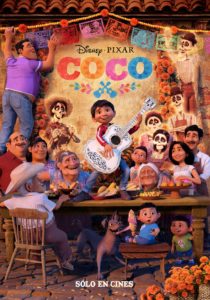The Disaster Artist
Posted on November 30, 2017 at 5:13 pm
B +| Lowest Recommended Age: | Mature High Schooler |
| MPAA Rating: | Not rated |
| Profanity: | Very strong language |
| Alcohol/ Drugs: | Alcohol |
| Violence/ Scariness: | Fictional depiction of suicide and violence, some scuffles |
| Diversity Issues: | None |
| Date Released to Theaters: | December 1, 2017 |
 Let’s face it. Failure is more fascinating than success. There are innumerable movies based on true stories about real people who overcame seemingly insurmountable obstacles with determination, vision, and talent to accomplish extraordinary achievements in sports, the arts, and shaping public policy. Movies like “Schindler’s List” and “The Big Short” help us to understand huge, complicated tragic failures through the prism of small victories. But there are also movies like “Florence Foster Jenkins,” with Meryl Streep as the legendarily awful singer and “Ed Wood,” with Johnny Depp as the legendarily awful movie director, that explore with some affection the stories of terrible failures, and they do it with vastly more skill than the people they depict could have imagined.
Let’s face it. Failure is more fascinating than success. There are innumerable movies based on true stories about real people who overcame seemingly insurmountable obstacles with determination, vision, and talent to accomplish extraordinary achievements in sports, the arts, and shaping public policy. Movies like “Schindler’s List” and “The Big Short” help us to understand huge, complicated tragic failures through the prism of small victories. But there are also movies like “Florence Foster Jenkins,” with Meryl Streep as the legendarily awful singer and “Ed Wood,” with Johnny Depp as the legendarily awful movie director, that explore with some affection the stories of terrible failures, and they do it with vastly more skill than the people they depict could have imagined.
In fact, that is part of what led to the failures in the first place — Florence Foster Jenkins and Ed Wood were exemplars of the Dunning-Kruger effect, which shows that the less competent people are, the more likely they are to be unable to evaluate their own competence. It isn’t the terrible end product that enthralls us as much as the buoyant optimism and imperishable self-regard that keeps these people going while the rest of us are consumed with doubt and insecurity.
“The Room,” from writer-director-star Tommy Wiseau, has been called “the ‘Citizen Kane’ of bad movies.” It is in that rare category of films that transcend “so bad it’s good” and “suitable for Mystery Science Theater commentary” into genuine hit, with well-attended midnight showings filled with fans who come to see it again and again. Like the midnight “Rocky Horror Show” screenings, fans come in costume and with props. An arty picture of a spoon in a frame that appears in many shots provokes a flurry of plastic spoons thrown at the screen. The crowd yells “focus” whenever someone should have reminded the cinematographer that the camera needed to produce a sharper image. And some people get happily tipsy taking a drink whenever any of the movie’s characters say “Hi.”
The film is based on a book co-written by Greg Sestero, who co-starred in “The Room.” For multi-degreed master of literary analysis James Franco, who directed and stars in the film, “Disaster Artist” is not an oxymoron. In his mind, Tommy Wiseau is an artist because he has a singular vision so urgent that he will realize it, no matter the cost, in the most literal terms. Wiseau is said to have spent six million dollars in making “The Room,” much of it as poorly decided as every other choice that went into making the film.
“The Room” tells the story (I use the term loosely, as the script is a mishmash of many unexplained developments and characters, with a plot even more out of focus than the camera) of Johnny (played by Wiseau, and Franco as Wiseau in this version), a successful banker who has a fiancee named Lisa (portrayed by Ari Graynor), a best friend named Mark (played by Dave Franco as Greg Sestero), and a teenage protegee of some kind named Danny (played by Josh Hutcherson). Lisa is bored with Johnny and begins an affair with Mark, though her mother pushes her to stay with Johnny because he is rich and treats her well. The film has extended soft-core-style sex scenes, a weird, inexplicable confrontation between Danny and a drug dealer, and another odd scene with guys in tuxedos tossing a football.
“The Disaster Artist” begins with Greg and Tommy meeting in acting class in Northern California, becoming friends in part because of their shared love for James Dean (coincidentally once played by Franco himself in a breakthrough performance) and dreams of being stars. They move to LA together, with Greg staying in Tommy’s apartment. Tommy is quite mysterious about his background (he has a strange eastern European accent), his age, and his source of income. He is supportive of Greg but also possessive. The decision to cast his own brother as Greg is Franco’s exploration of a mirrored duality in their relationship and there is more than a hint of some boundary issues that may reflect homoerotic feelings.
Frustrated by his lack of success in Hollywood and jealous that Greg is getting some work, Tommy decides to write and produce his own movie. And so we see how many bad decisions go into creating the “Citizen Kane” of terrible cinema. But we also see a very rare example of a film, usually the ultimate artistic reflection of teamwork, that is a genuinely singular vision. As muddled and incoherent as it is, it is exactly the movie he had in his head and exactly the movie he wanted to make. Franco clearly respects that, as Tim Burton did with “Ed Wood” (with Vincent D’Onofrio’s Orson Welles as his stand-in showing one director saluting another). The audiences in the midnight shows are there to jeer and feel superior. Franco, in his performance and direction, is sympathetic, giving Wiseau and his story the film he was not able to give himself.
NOTE: Be sure to stay through the credits for some uncanny side-by-side re-creations of scenes from “The Room” with the cast of this film.
Parents should know that this film includes nudity, sexual references and situations, depiction of suicide and violence, alcohol, and very strong language.
Family discussion: What does it mean that something is “so bad it’s good?” What does this movie tell us about the decisions that go into making a work of art?
If you like this, try: “The Room,” of course, and the book by Sestero, and the bonkers “Beaver Trilogy” documentary



